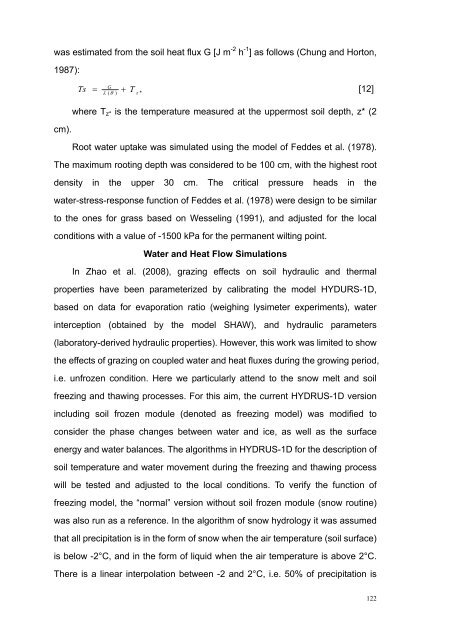SCHRIFTENREIHE Institut für Pflanzenernährung und Bodenkunde ...
SCHRIFTENREIHE Institut für Pflanzenernährung und Bodenkunde ...
SCHRIFTENREIHE Institut für Pflanzenernährung und Bodenkunde ...
Create successful ePaper yourself
Turn your PDF publications into a flip-book with our unique Google optimized e-Paper software.
was estimated from the soil heat flux G [J m -2 h -1 ] as follows (Chung and Horton,<br />
1987):<br />
cm).<br />
G Ts = + T<br />
λ ( θ ) z *<br />
[12]<br />
where Tz* is the temperature measured at the uppermost soil depth, z* (2<br />
Root water uptake was simulated using the model of Feddes et al. (1978).<br />
The maximum rooting depth was considered to be 100 cm, with the highest root<br />
density in the upper 30 cm. The critical pressure heads in the<br />
water-stress-response function of Feddes et al. (1978) were design to be similar<br />
to the ones for grass based on Wesseling (1991), and adjusted for the local<br />
conditions with a value of -1500 kPa for the permanent wilting point.<br />
Water and Heat Flow Simulations<br />
In Zhao et al. (2008), grazing effects on soil hydraulic and thermal<br />
properties have been parameterized by calibrating the model HYDURS-1D,<br />
based on data for evaporation ratio (weighing lysimeter experiments), water<br />
interception (obtained by the model SHAW), and hydraulic parameters<br />
(laboratory-derived hydraulic properties). However, this work was limited to show<br />
the effects of grazing on coupled water and heat fluxes during the growing period,<br />
i.e. unfrozen condition. Here we particularly attend to the snow melt and soil<br />
freezing and thawing processes. For this aim, the current HYDRUS-1D version<br />
including soil frozen module (denoted as freezing model) was modified to<br />
consider the phase changes between water and ice, as well as the surface<br />
energy and water balances. The algorithms in HYDRUS-1D for the description of<br />
soil temperature and water movement during the freezing and thawing process<br />
will be tested and adjusted to the local conditions. To verify the function of<br />
freezing model, the “normal” version without soil frozen module (snow routine)<br />
was also run as a reference. In the algorithm of snow hydrology it was assumed<br />
that all precipitation is in the form of snow when the air temperature (soil surface)<br />
is below -2°C, and in the form of liquid when the air temperature is above 2°C.<br />
There is a linear interpolation between -2 and 2°C, i.e. 50% of precipitation is<br />
122


